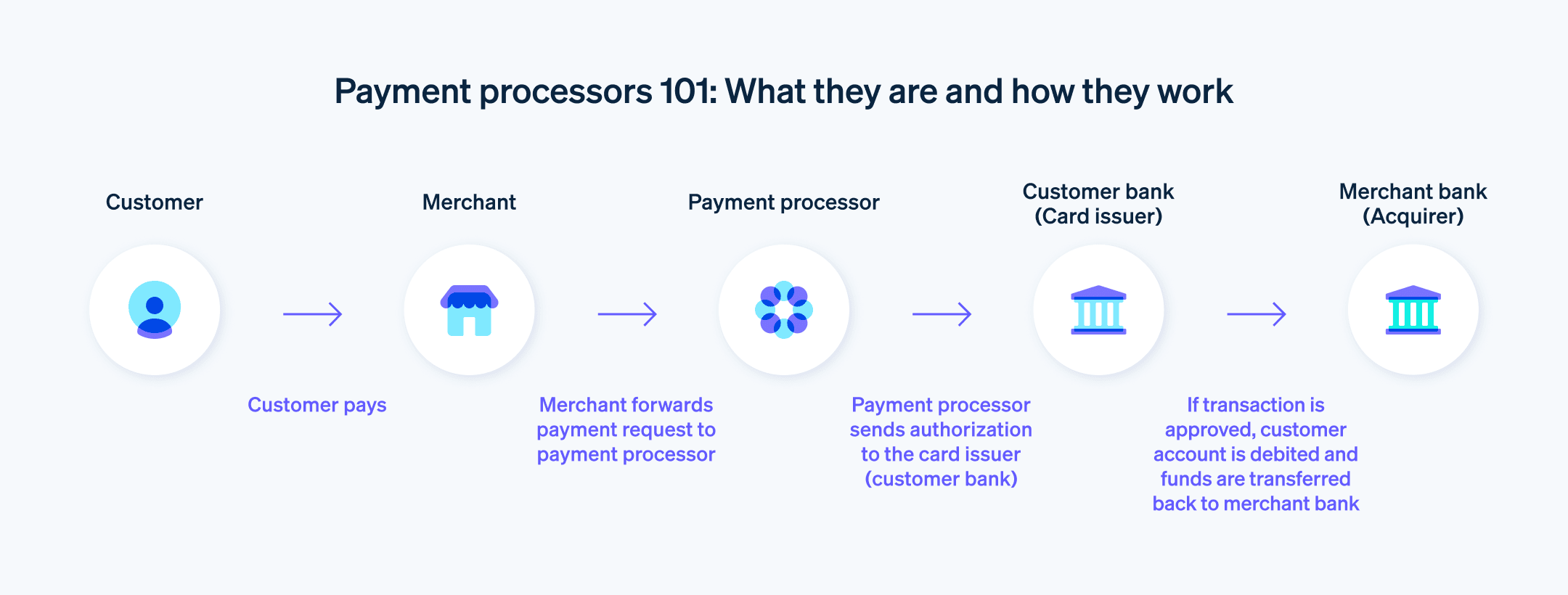通过多种渠道(线下、线上和移动)接受电子支付的企业需要应对各种复杂性。这包括选择合适的支付处理商,这是一个重要的决定,可能会影响长期成功并影响业务的多个方面。
随着越来越多的企业在全球范围内扩张,对多币种和本地化支付选项的需求也在不断增长。为了满足这些不断变化的需求,企业主和企业家应该充分了解选择支付处理商时要考虑的关键因素。
下面,我们将定义什么是支付处理商,讨论支付处理提供商 如何工作,并描述了支付处理 的各个方面,从费用和定价结构到安全措施和全球支持。
目录
- 什么是支付处理商?
- 支付处理商是做什么的?
- 支付处理商如何工作?
- 如何选择支付处理商
什么是支付处理商?
支付处理商是促进企业与其客户之间的电子交易(例如使用信用卡、借记卡或数字钱包进行的付款)的公司或服务。支付处理商使企业能够安全快速地接受各种形式的付款,并协助将资金从客户账户转移到企业账户。
支付处理商是做什么的?
支付处理商在电子支付生态系统 中发挥着重要作用,使企业能够接受和处理来自客户的各种形式的付款。下面概述了支付处理商的主要功能:
为交易提供便利
当客户购物时,支付处理商会收到交易详细信息,并通过卡组织 将此信息安全地传输给相关方,包括发卡行(客户的银行)和收单行(企业的银行)。授权和身份验证
支付处理商请求授权,以确保客户有足够的资金或信用可用。它还验证客户的身份和支付方式的有效性,以更大限度地减少欺诈和未经授权的交易。加密和安全
为了保护敏感的财务数据,支付处理商使用加密和令牌化在客户、企业和银行之间安全地传输交易数据。他们还需要遵守支付卡行业数据安全标准 (PCI DSS),以维护用于处理持卡人信息的安全环境。结算和资金
交易获得授权后,支付处理商协调将资金从发卡行转移到收单行。然后,商家账户 记入交易金额,减去任何适用的费用。用于报告和分析的数据
支付处理商生成有关客户付款的数据,这些数据可用于生成交易报告、分析和见解,以帮助企业跟踪销售、识别趋势并更有效地管理其业务。欺诈检测和拒付管理
支付处理商使用先进的算法和工具来监控交易是否存在欺诈活动,帮助企业尽可能降低遭遇欺诈事件的概率。他们还可能在处理拒付 和争议方面提供支持和协助。支持多种货币和支付方式
为了帮助企业在全球范围内扩张,许多支付处理商都支持多种货币和流行的本地支付方式。例如,Stripe 支持超过 135 种货币,允许企业在全球范围内开展业务并以当地货币接收付款。
支付处理商如何工作?
支付处理商为客户与企业之间的电子交易提供便利,但商家可能并不了解这一过程的细节。为了解支付处理商的运作方式,下面让我们详细描述一下典型的支付处理流程:
客户发起付款
当顾客进行购物时,他们会向商家提供支付信息,如信用卡信息或数字钱包信息。这可以在销售点 (POS) 终端面对面进行,也可以通过电商网站、移动应用或通过支付链接线上进行。交易数据加密
企业的支付系统对交易数据进行加密,确保其安全地传输到支付处理商。此加密有助于防止诈骗分子拦截和滥用敏感的客户信息。交易数据传输
加密的交易数据从企业发送到支付处理商,随后支付处理商将其转发给收单行。收单行到发卡行
收单行通过相应的银行卡组织(如维萨 (Visa)、万事达 (Mastercard) 或美国运通 (American Express))将交易详细信息转发给发卡行进行授权。授权请求
发卡行审查交易详情,并检查客户是否有足够的资金或信用额度。它还会核实支付方式及客户身份的真实性,以降低欺诈风险。授权响应
如果发卡行批准了交易,则会通过卡组织将授权代码发送回收单行。如果交易被拒绝,发卡行会发送一条带有拒付代码的拒绝消息,解释交易未获批准的原因。处理商接收响应
支付处理商接收收单行的响应,并将其转发给企业。如果交易获得授权,企业即可继续完成销售。如果交易被拒绝,企业必须向顾客要求使用其他支付方式。交易完成
交易获得授权后,企业就会将商品或服务交付给客户。此时,尽管实际的资金转移尚未发生,但该笔交易被视为已完成。捕获和结算
“捕获”是指针对特定交易,将资金从客户账户转移至商户账户。通常,企业会在一天结束时,将一批已授权的交易发送给支付处理商进行结算。然后,支付处理机构将这批交易提交给收单行,收单行随即启动资金从发卡行转移至商户账户的流程。这种资金转移通常需要 1-3 个工作日,具体时间取决于所涉及的支付处理商和银行。

虽然这是支付处理商通常遵循的一般流程,但根据支付方式和行业的不同,不同类型的支付和支付场景会存在一些差异及特殊考量。若想深入了解软件即服务 (SaaS) 公司支付处理的具体细节,可查看此处。若要更深入地探究在线支付处理流程,请阅读我们关于该主题的指南。
如何选择支付处理商
支付处理商直接影响客户体验、交易安全性、现金流和支付流程的整体效率。选择支付处理商需要充分了解您现在和将来随着业务发展壮大的确切需求。考虑到这一点,在选择支付处理商时,您应该考虑以下一些因素:
费用和定价
了解支付处理商的费用结构,其中可能包括设置费、交易费、月费、拒付费和货币兑换费。寻找符合您企业交易量和预期增长的定价模式。一些处理商提供分层定价或统一费率,而另一些处理商则根据每笔交易的百分比加上固定费用收费。有关 Stripe 定价模式的详细信息,请访问此处。接受的支付方式
确保支付处理商支持客户最有可能使用的支付方式。这可能包括信用卡、借记卡、数字钱包、先买后付 (BNPL) 以及任何适合当地情况的付款方式。例如,货到付款 (COD) 在某些市场被广泛使用,但在其他市场则根本不使用。提供多种支付方式可以提高客户满意度和转化率。安全性与合规性
验证支付处理商是否遵守行业标准(例如 PCI DSS),以确保有一个安全的环境来处理敏感的客户信息。此外,还要考虑处理商的欺诈检测和预防功能,以及它们对令牌化和加密等安全技术的支持。有关 Stripe 如何保障安全性并协助企业轻松合规的更多详细信息,请点击此处。国际支持
如果您的企业在多个国家/地区开展业务或计划在全球范围内扩张,请寻找支持多种货币和流行的本地支付方式的支付处理商。此外,评估他们的货币兑换费和国际交易费。集成和兼容性
选择与您现有的电商平台、POS 系统或其他商业软件兼容的支付处理商。大多数处理商都提供易于使用的 API、插件或 SDK,允许与各种平台无缝集成。如需详细了解 Stripe 的支付 API,请点击此处。易用性和客户体验
评估客户的结账用户体验,以及企业的报告和交易管理体验。界面应该直观、对用户友好且高效。客户支持
评估支付处理商客户支持的质量和可用性。理想情况下,他们应该通过多种渠道(例如电话、电子邮件和实时聊天)提供全天候支持,就像 Stripe 一样。查看在线评论和推荐,以衡量其支持团队的响应速度和乐于助人的程度。可扩展性和灵活性
随着业务的增长,您的支付处理需求也会随之变化。寻找可以随您的企业一起扩张并提供订阅计费、开票和经常性付款等功能的处理商。想想五年后您的支付处理需求可能是什么样子,并确保支付处理商能够支持您未来的业务需求。合同条款和取消政策
查看支付处理商的合同条款,包括任何最低要求、提前终止费用或其他潜在限制。寻找一个条款透明、灵活、适合您业务需求的处理商。
通过仔细考虑这些因素,企业可以选择最符合其特定要求的支付处理商,确保内部团队和客户在不同渠道都能获得简单、安全的支付体验。
本文中的内容仅供一般信息和教育目的,不应被解释为法律或税务建议。Stripe 不保证或担保文章中信息的准确性、完整性、充分性或时效性。您应该寻求在您的司法管辖区获得执业许可的合格律师或会计师的建议,以就您的特定情况提供建议。